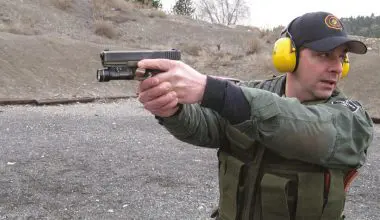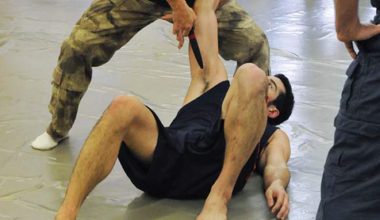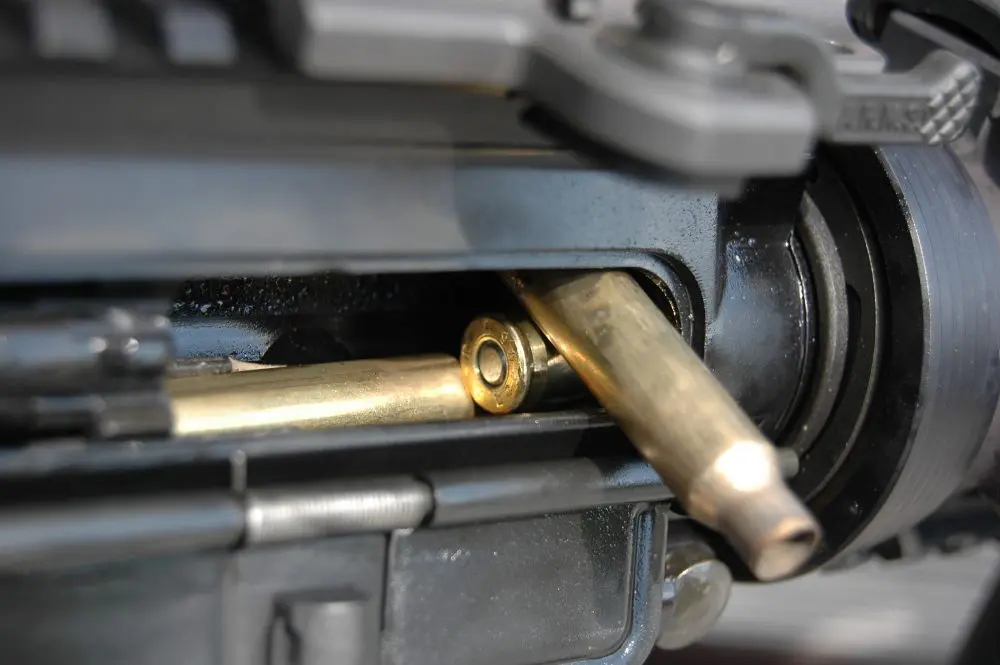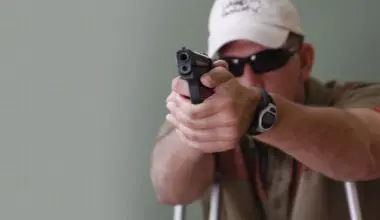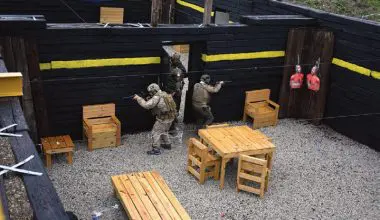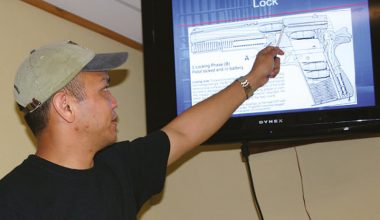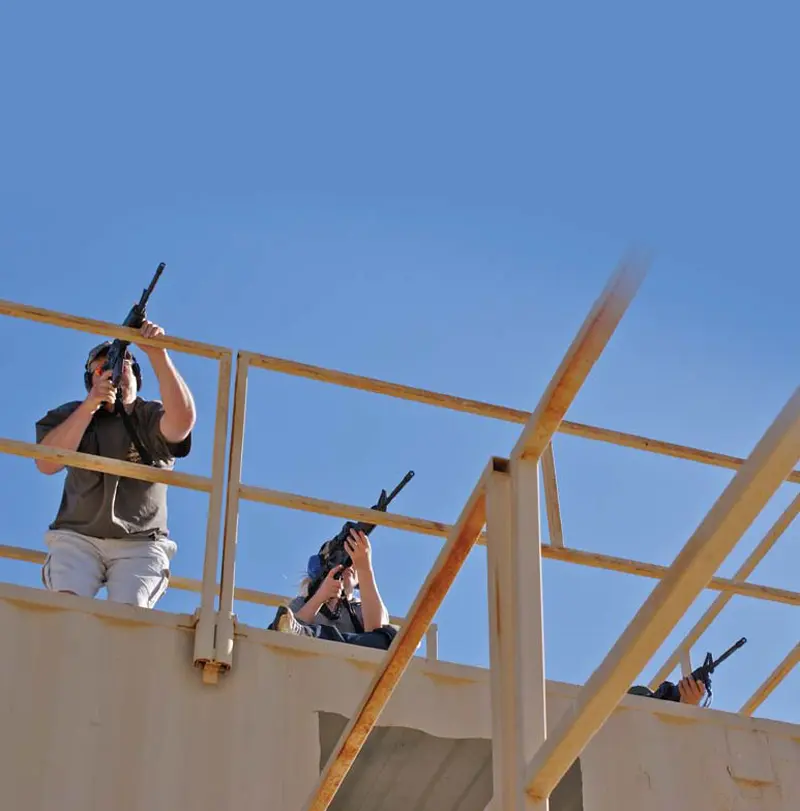
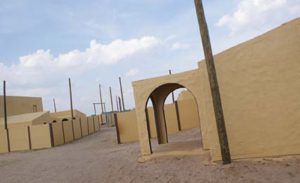
And Remington Rifle 1 at High Caliber Training is a great class in which to learn the basics of sniping. It’s designed to teach solid firsthit skills at long range.
High Caliber Training (HCT) is the counterpart facility to Tier 1 Group, or as it’s known in military circles, T1G. When you attend HCT, you’re actually receiving training from the same folks who train our military. I arrived early at T1G/ HCT for a tour of their extensive facility.
The head man at T1G/HCT is Steve Reichert. Steve is a Bronze Star recipient with a “V” cluster for valor in combat as a Marine Scout Sniper in Iraq. I don’t want to do any injustice to his valiant actions in combat by condensing them to fit into this article, so I suggest you Google him and read his complete story.
Table of Contents
SITE TOUR
Steve was away on business upon my arrival at T1G/HCT, so instructor Raj Chowdhuri gave me a full tour of the extensive 780+ acre facility. HCT is located in Crittenden County, Arkansas, just 20 minutes from downtown Memphis. The comprehensive training facility offers multiple ranges and facilities, including rifle ranges out to 1,500 meters, steel reactive targets, vehicle and urban training facilities, and full-scale Afghan villages detailed right down to those weird-looking sky-blue painted gates.
HCT also has two configurable livefire houses that have over 12,000 combined square feet. The area surrounding the houses features a nine-foot compound wall with multiple explosive and vehicular breach points.
The HCT training facility is on the cutting edge of proficiency and capability. A good example of this is their two-mile high-speed driving course, which incorporates several areas where ambushes can be executed. Not only can you learn to make high-speed vehicle maneuvers, you can also learn to fight from within the vehicle.
In addition to military and LE, this facility is open to properly vetted civilians.
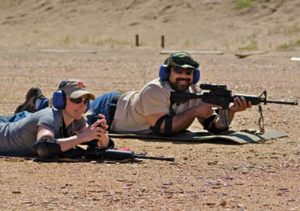
MINI SPR
For this class I had the opportunity to try out a new rifle from Spike’s Tactical. The rifle that was delivered was a limited edition Spike’s Tactical Billet Mini SPR, and it was a sight to behold. Ambidextrous everything describes this rifle well. The lower came with full ambi controls machined in, not just retrofitted in. With Magpul kit like a CTR, MIAD, MBUS, PMAGs, and MS2, the rifle was tricked out but not cumbersome. Other additions were a Daniel Defense QD sling mount and Spike’s custom nickel Boron trigger.
The upper, while clearly an entirely new design, still conforms to milspec at the front so as to accept all known rail systems, as evidenced by the use of a Daniel Defense 12-inch rail.
Bravo Company pitched in on this project as well and sent me some of their new BCM Gunfighter charging handles. They’re designed with a self-supporting latch that transfers the forces of aggressive cycling away from the roll pin and onto the solid rear of the charging handle, thus eliminating split charging handles.
The finished rifle sports a 16-inch barrel. The Lothar Walther, LW-50, 1:8 polygonal right-hand twist, stainless steel barrel is far above the standard grade of milspec barrel stock. The German- made non-chrome lined barrel delivers outstanding accuracy.
During initial zeroing, I was able to stack multiple rounds from 100 yards into areas the size of a dime. My friend and fellow officer Matt Purvis (who, like me, was in awe of the accuracy delivered by this SPR) verified this. Two additions to the rifle were partly responsible for this.
The first was an Advanced Combat Bipod from TangoDown. Without this bipod holding the weapon steady, longrange work would’ve been difficult. This bipod is sturdy enough to push against, further steadying the weapon. Like all TangoDown products, it worked with zero malfunctions.
The second piece of gear added to the SPR was a scope from Nightforce Optics. Shortly after my emailed request was sent, Nightforce contacted me to ask what the intended weapon and bullet weight would be. Nightforce was able to build a scope that perfectly filled the needs of a semi-auto .223 rifle firing 77- grain Remington MatchKing BTHP.
The Nightforce Optics Compact NXS 2.5-10X32 is graduated all the way out to 600 yards, and even has windage marks at five- and 10-miles per hour increments for cross-wind compensation. The craftsmanship and attention to the smallest details come through in Nightforce products with a level of clarity that is unparalleled for the price.
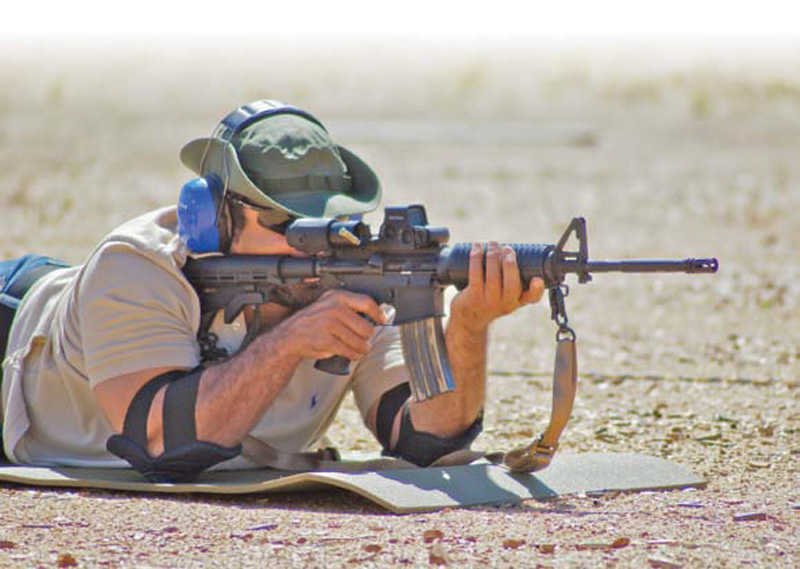
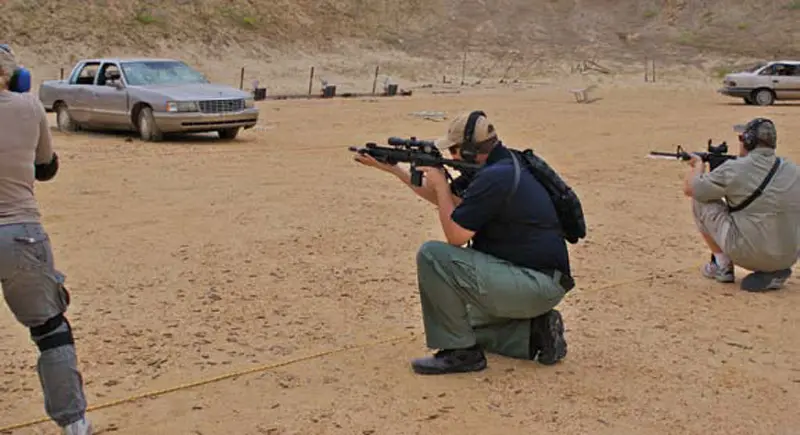
TRA INING DAY 1
Normally I enjoy a larger class, but when the subject matter is precision shooting, a small class is really the way to go. On Day 1, I was pleased to find that there were only five of us in this class. My classmates—David, Michelle, Robbie and Tillie—were all from New Orleans, and were also husband and wife teams of shooters.
After student introductions were made, our instructor, Craig Sawyer, introduced himself, then gave us a brief outline of the course. From the moment you meet him, Craig engages you with his expansive knowledge of precision shooting. He is an excellent instructor who, as a former spec-ops soldier, has many different facets of knowledge from which to draw. Craig has served our nation as a Marine Sniper, SEAL Sniper, Federal Air Marshal, and Dignitary Protection Specialist.
READING THE MIRA GE
We spent the first half of Day 1 covering scope theory, weapons manipulation, various shooting positions and dry firing. Craig did an excellent job of breaking the basics down for us. As a writer, I spend some time watching the instructors working with students. In this course, I enjoyed seeing the learning process among my classmates. Later, Craig told me that he gauges his classes’ ability as a whole and then teaches as quickly or as slowly as is needed to be sure that everyone moves ahead together and retains what they’re shown.
After lunch, we met on the range to zero our weapons. It was a windy Arkansas day with gusts that were fairly strong at times. We carefully zeroed our optics, and Craig used the environment as a teaching point on how to read conditions.
Using the heat mirage rising off the ground to judge wind conditions was an exceptional tool. On a hot summer day, the heat wafts up off the ground in lazy, vaporous sheets of distorted light. When you put 200 yards between you and your target, and you’re only ten inches off the ground, those mirages take on a different appearance. Through my NXS scope, the mirage looked more like undulating ripples of energy covering the ground. Each shift of the mirage gave the wind’s intentions away and helped us strike our targets more efficiently.
The remainder of Day 1 was spent tightening our zeros and learning how our individual weapons grouped at different ranges. Late in the afternoon, the SPR started to malfunction by failing to lock open on the last round. The gun fired every time I pulled the trigger but repeatedly failed to lock open.
Since mags are often to blame for malfunctions, I swapped them out, but the problem persisted. I knew the Remington ammo wasn’t the problem and confirmed this by switching to some milspec 5.56mm—same problem. I suspected it might be the gun, but as long as a weapon fires when I pull the trigger, I keep shooting. I finished the day with the problem still plaguing every firing evolution.
When I got to the hotel that evening, I broke my rifle down and found that it was severely contaminated with sand. The cause and effect became instantly clear. After every evolution we would “clear and lock,” then show an empty chamber to Craig. My classmates, who were shooting off of bags, would then lay their ARs on the deck, ejection port down. I, on the other hand, always left my rifle on its bipod with the ejection port open to the Arkansas silt. Live and learn.
TRA INING DAY 2
Before class on Day Two, I cleaned the SPR thoroughly and lubed it with SLiP2000™ EWL (Extreme Weapons Lubricant). Upon firing the first mag, it locked cleanly to the rear. Problem solved.
After a quick recheck of our zeros, we moved on to some high-speed accuracy drills at seven yards. If while en route to a position of over-watch you find yourself under attack, it’d be good to know how to defend yourself with your sniper rifle in a CQC engagement. This upclose drill emphasized the importance of bore line/sight line offset.
After lunch, we moved back to the 200. Previously we’d been shooting at paper targets in perfect alignment with our field of view. These were replaced with nine LaRue Tactical auto-resetting targets at various distances—some as close as 50 yards, others as far out as 200 yards. It was our job to drop them as quickly as possible using shooter/ spotter teamwork. We were all shooting semi-auto AR variants, which made for faster firing evolutions and more turns all around. With the small class size, Craig was able to give each student tailored instruction that made for better retention.
The majority of the day consisted of class time, then shooting to drill in what we’d learned from the dry-erase board. By the afternoon, we were doing better as a group, and most every shot fired was immediately followed by the “pong!” of steel going down. This is where the NXS really showed its stuff. At 200 yards, I could see the steel plates crisply and was calling out my shots with deadly precision.
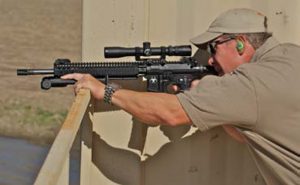
TRA INING DAY 3
This was the day I’d been waiting for.
HCT has a five-story-high sniper tower. It’s constructed of steel shipping containers that have been stacked in a square structure, with each ascending level opposing the other.
At this point, Craig really started to mix things up for us. I must say that Craig was the consummate professional without being boring. He demonstrated various examples of how to get a shot off at an enemy from inside a structure, and then had us try all of them. He emphasized, “Around the corner, over the edge, stack chairs on a table, make a crude sniper blind out of anything you can find. Whatever it takes to get the shot, you do. Think outside the box and use your environment as needed. It’s better to travel light and be creative than to plan for every contingency and be bogged down with way too much gear.”
At 350 yards, five stories up, in a mostly arid environment, you can kiss your mirage goodbye. And you don’t have foliage to help you gauge wind conditions either. So what’s left? Look through your scope—what do you see? Trash tumbling along, sand swirling around fixed objects, the intermittent swaying of a light pole. Look carefully enough and you’ll find a way to read the wind. We started watching tumbling scraps of paper, discarded gum wrappers and shifting sand.
Craig called out, “Use your tactical breathing to slow your heart rate down, concentrate on your cross hairs’ movement with every heartbeat.” He was right: we would watch our guns’ movement diminish as our hearts slowed then, “boom, pong!”
I coaxed Craig over to the SPR and watched a master do his thing. What it took us to do from prone, Craig did by leaning against a wall and pushing into a railing. It was impressive to watch that level of proficiency. I’m envious.
Near the end of Day 3 I’d blown through all my ammo, which allowed me the opportunity to stand back and watch my classmates interact with each other and Craig. David and Michelle, who’d started off uneasy and uncomfortable with their guns, were now pretty much killing everything in sight. Robbie had gotten out his .308 bolt gun and was really drilling the steel, while Tillie stood back and gave moral support as she too was done for the day.
TAKE THIS CLASS !
I speak for all five students when I say that HCT’s Remington Rifle 1 is a great class, and Craig Sawyer more than exceeded our expectations. He was so dialed in to teaching us and meeting our needs that he never once tried to regale us with war stories that would puff him up. I liked that about him and mentioned it to my fellow students, who in turn said, “But you can’t take a class from a SEAL and not get a story or two.” So we ambushed Craig during one of his on-range scope theory lessons and dragged a couple of stories out of him. Next time you get a chance, thank a soldier for your freedom. Thank you, Craig.
Many thanks to Steve Reichert and his hardworking crew at T1G/HCT. As of this writing, my classmates have already returned for more advanced training, and as soon as I can arrange it, I will too. T1G/HCT is a superb place to hone your skills as a citizen and/or an officer. Do yourself a favor and take a class or two from them this year. You won’t regret the investment.
